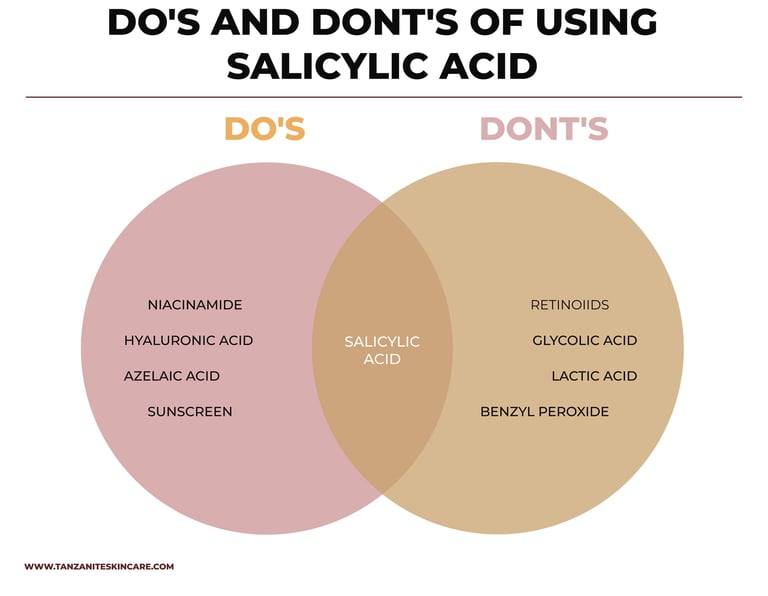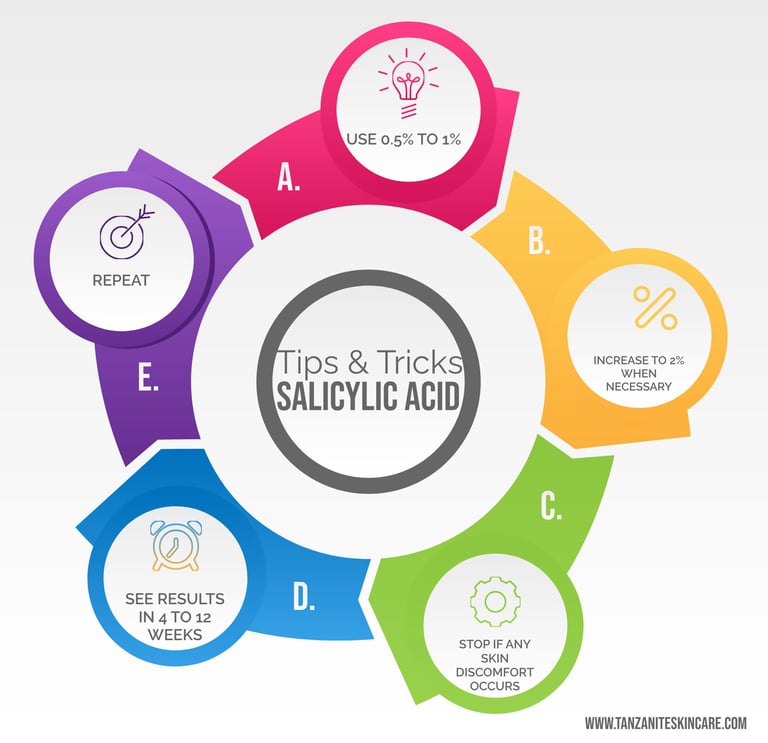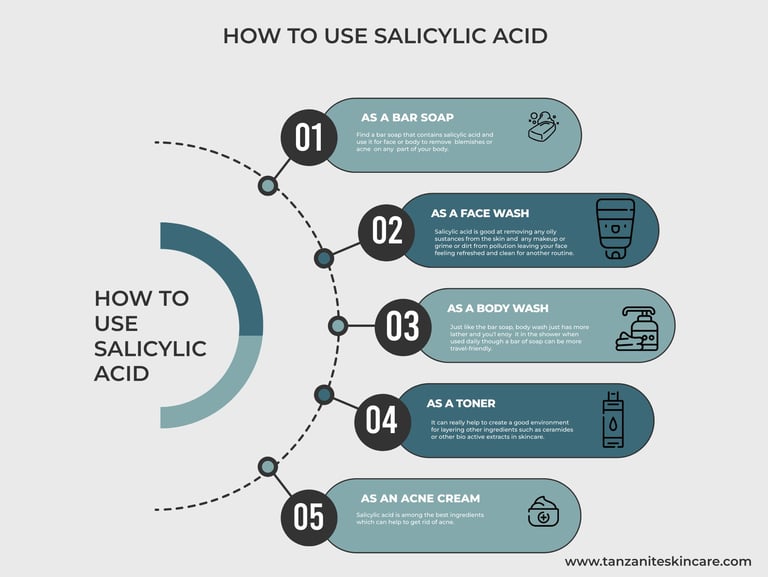Salicylic Acid Benefits: Can It Get Rid of Acne?
SKINCARE INGREDIENTS


Overview
When it comes to over-the-counter (OTC) options for acne treatment, salicylic acid comes to mind. Among BHAs(Beta Hydroxyl Acids) this is the most popular exfoliating acid rivalling glycolic acid, an AHA(Alpha Hydroxyl Acid).
Salicylic acid, a BHA is an oil-based exfoliant that can remove excess oil (sebum) from the skin. Salicylic acid can be widely found in skincare products such as face washes, cleansers, gels and body washes even soap bars. Sometimes, salicylic acid can be incorporated in creams, moisturizers or lotions.
Salicylic acid has affinity to oiliness making it a right choice for anyone who has oily, blemish or acne-prone skin type. This does not mean by any means that other skin types can’t benefit from salicylic acid, with moderation and ‘listening to your skin needs’ you can craft a skincare routine that will eventually work for you.
Table of Contents
1.0 Overview
2.0 Where Does Salicylic Acid Come From?
3.0 Salicylic Acid Uses For Skin
4.0 What are the Disadvantages of Salicylic Acid on Skin?
5.0 Salicylic Acid and Skin Types
6.0 What can be Paired with Salicylic Acid?
7.0 What Cannot be Used with Salicylic Acid?
8.0 What happens if you use salicylic acid everyday?
9.0 How to Use Salicylic Acid In Your Skincare Routine
10.0 Frequently Asked Questions
11. 0 References
Where Does Salicylic Acid Come From?
Salicylic acid can occur naturally in plants even bacteria. It can be found in abundance in willow bark, meadowsweet and wintergreen where methyl salicylate is derived.
Though in skincare industry, we’ve found a way around that by making it in the laboratories since it way more cheaper alternative to the natural harvesting route.
Salicylic acid is manufactured from chemical reactions between sodium phenoxide with carbon dioxide in high temperature and pressure which produces sodium salicylate that can be converted to salicylic acid through acidification whereby acids like sulfuric acid might be involved.
Salicylic acid will be purified and packaged to wholesalers who are going to sell them to companies that will use it in their formulations of various skincare products in smaller concentrations for consumers.
How Does Salicylic Acid Works?
Salicylic acid is good at exfoliating the skin and sticking to oil particles that would otherwise clog your pores.
Dr. Sandra Lee aka ‘Dr Pimple Popper’ provide a simple explanation, “…our pores get clogged with oil debris dead skin and bacteria and this is really what starts acne so by unclogging your pores with salicylic acid it helps to sweep away this ‘debris’, sweep away this oil and destroy this bacteria and therefore hopefully your acne gets better or is prevented in the first place.”
FUN FACTS
Salicylic acid was used as a food preservative and pain reliever. Later, concerns about its toxicity and causing stomach upset led to it stop being used.
Salicylic Acid is the precursor to popular pain reliever called Aspirin.
Tanzanite Skincare
Salicylic Acid Uses For Skin
In skincare industry, salicylic acid containing products, prescribed or over-the-counter (OTC), can be used to treat acne breakouts, hyperpigmentation, oil control among many other things. Here’s the following:
Reduce Blackheads and Acne Breakouts
Reduce Post-Inflammatory Hyperpigmentation (PIH)
Control Sebum Production
Exfoliate Dead Skin Cells
It has Anti-inflammatory Properties
Minimizes and Clear Pores
It has Anti-aging Properties
Tanzanite Skincare
1. Reduce Blackheads and Acne Breakouts
When it comes to acne treatment, salicylic acid is among the best options available. With just as low as 0.5% to 2% concentration, salicylic acid in formulation can prevent occurrence of acne due to its anti-bacterial properties that make it unsuitable for P.Acnes to grow and flourish on the skin’s surface.
It can also clear blackheads and whiteheads that can ruin your face if not taken care of. In case of bacne (back acne) or acne that affects a lager area of the body salicylic acid spray may become handy.
One double-blind placebo-controlled evaluation using 2% salicylic acid cleanser found out that there was significant improvement of acne vulgaris.
Another study discovered that salicylic acid could treat acne by suppressing AMPK/SREBP1 pathway that could inflame acne lesions.
2. Reduce Post-Inflammatory Hyperpigmentation (PIH)
Another thing that salicylic acid is good at is fighting off hyperpigmentation. It is good for those with highly melanated, oily or sensitive skin since it has less chances to induce post-inflammatory hyperpigmentation (PIH). Unlikely glycolic acid which can be an irritant and cause PIH, salicylic acid is way more gentler and can be well-tolerated by these skin types.
A clinical study did assess efficacy and safety of salicylic acid peels ranging from 20% to 30% on dark skin and found out that the peels could be tolerated and showed reduction of PIH in tested subjects.
3. Controls Sebum Production
If you have skin oiliness then salicylic acid can help to reduce overproduction of sebum, excess natural oil that can make your skin shiny, tacky and uncomfortable. But also create a suitable environment for clogged pores and acne cysts.
Since salicylic acid has ability to cling to oil molecules then it can remove oil, grime, dirt and even makeup that’s why it is always wise to use oil-based cleanser (more likely to contain salicylic acid) after micellar water in order to have cleaner face to work with in your skincare routine. This is usually referred to as Double Cleansing.
A clinical study observed that 30% supramolecular salicylic acid peel treated acne as well as reduce facial sebum in the process.
4. Exfoliate Dead Skin Cells
As we already know, salicylic acid in an exfoliant. It can help to remove dead skin cells by breaking up keratinized cells within stratum corneum to reveal new, radiant and youthful skin. Salicylic acid could encourage cell renewal and cell turnover in the process.
One study about chemical peels found salicylic acid to be a right candidate in treating melasma, photodamage, lentigines, acne and freckles. It was also found to be less harsh to darker skin than AHAs or phenol deep peels.
5. It has Anti-inflammatory Properties
Salicylic acid is less of an irritant and can be well-tolerated by various skin types compared to other exfoliants such as TCA, TXA or glycolic acid. They can be used in less concentration and still bring out the best results.
Salicylic acid is less likely to cause skin redness, burning sensation, dryness, flushing and peeling.
Scientific studies prove that salicylic acid has indeed anti-inflammatory properties. It is a confirmed inhibitor of oxidative stress.
6. Minimizes and Clear Pores
On the process of unclogging pores by dissolving oily dirt within pores can help to reduce size of pores. Larger pores will shrink since there’s less and less oily dirt to hold as you apply salicylic acid skincare products day after day or every other day creating smooth skin with smaller pores.
7. It has Anti-aging Properties
You have to know that salicylic acid is not only an exfoliant but also has anti-aging properties that can help to fight free radicals. But also salicylic acid can provide photoprotection by reducing chances of UVA and UVB rays affecting the skin.
A clinical study used sodium salicylate (salicylic acid derivative) to subjects and found some anti-aging benefits such as reduced wrinkle depth and skin roughness after 8 weeks of daily use. It was also found to be suitable for subjects with sensitive akin.
What are the Disadvantages of Salicylic Acid on Skin?
Among hydroxyl acids, either it is AHAs and BHAs salicylic acid is more gentler than glycolic, lactic acid or phenol peels. Though some people can find it irritating but most of the time symptoms like
Itchiness
Burning sensation
Peeling
Dryness
Irritation
Most of these symptoms can be fixed with scheduling a good skincare routine and knowing when to use in routine steps. Knowing your skin types can also help you fitting your salicylic acid well in your routine.
Whenever you start using skincare products with salicylic acid, in order to reduce risks start with small concentrations of 0.5% and instead of using it daily, use only from 3-5 a week or every other day. You can always increase concentration to 1% to 2% as well as use it everyday checking if your skin can handle it.
Salicylic Acid And Skin Types
Knowing your skin type can be a vital thing in planning any skincare routine. It can help you on how to plan when and at which step to use a certain skincare active ingredient. Here you’ll learn how to use salicylic acid according to your skin type as follows:
Salicylic Acid and Oily Skin
You probably already come across salicylic acid 2% skincare products that’s what you are here. For those with oily skin salicylic acid face cleanser is highly recommended to have clear, less oily skin. It will be good to include salicylic acid during your PM skincare routine.
You can use 0.5% to 1% concentration especially if you’ll be using it everyday. Skip every other day if you find your skin to be getting dry or peeling as salicylic is an exfoliant and over-exfoliation may occur. You can also schedule your routine to have rest in weekends and not use it in those days.
So, who is Salicylic Acid For?
Dr. Idriss says, “It is for people with oily skin who have acne prone skin it can be used by other skin type as well and let’s say you’re not somebody who’s super oily or super acne prone, acne prone ,acne prone but you want to keep things under control you can incorporate a salicylic acid once a week into your routine to kind of keep your skin regulated…”
Salicylic Acid and Blemish or Acne-Prone Skin
It is an arsenal for anyone that deals mild, hormonal acne, whiteheads and blackheads. Salicylic acid boasts of anti-bacterial and anti-aging properties that may help to get rid of acne but also deal with PIH left behind with acne scars.
You can always use it daily with percentages of 0.5% to 1%. Though many acne products containing salicylic acid usually go to 2%, in this case, you can just use the products every other day and look out for signs of erythema, itchiness or irritation to see if you can use it only three time a day or skip it all.
Salicylic Acid and Combination Skin
Now for this skin type where some skin patches may feel dry and others oily, salicylic acid may help you attain a healthy skin barrier by reducing sebum production, exfoliate dry patches and offering the anti-aging properties that may overall help your skin have even texture and complexion.
Salicylic Acid and Dry Skin
You may not necessarily need to use salicylic acid but since it has exfoliating properties, it can be good to use 3 times a day. It can help exfoliate dead skin cells to allow for cell turnover and reveal new, radiant, youthful appearance.
Salicylic Acid and Sensitive Skin
If you’re looking for superficial exfoliating ingredient then forget about glycolic acid, TCA or TXA and instead look for salicylic acid. Since you have sensitive skin then look for a more gentler derivative sodium salicylate that can exfoliate your skin to reduce wrinkles, minimize pores, sebum and hyperpigmentation.
Salicylic Acid and Dark Skin
Among the BHAs and AHAs, salicylic acid is considered gentler and less harsh of exfoliants. Many AHAs can have side effects of causing PIH, though dark skin seems to handle and tolerate well salicylic acid containing formulations.
Salicylic Acid and Normal Skin
If you have normal skin you have wide field to try out salicylic acid skincare products with variety range of concentration then settle for the one that fits your needs. See no changes? Ditch it and look for another BHAs or AHAs to create a well-rounded skincare routine.
Salicylic Acid and Other Skincare Ingredients
What Can be Paired with Salicylic acid?
You can always pair salicylic acid with other skincare active ingredients in order to reap more benefits out of it.
Salicylic Acid and Niacinamide
If you want to use them together, use salicylic acid as a cleanser then apply niacinamide serum to soothe newly exfoliated skin, but also niacinamide can brighten acne scars and salicylic acid can reduce skin oiliness.
Salicylic Acid and Hyaluronic Acid
Which is Better, Hyaluronic Acid or Salicylic Acid?
Both hyaluronic acid and salicylic acid can be helpful for skin health. When it comes to using these active ingredients, they can be used together with optimal results.
Don’t be scared with the word ‘acid’ since hyaluronic acid is not an exfoliating ingredient as salicylic acid. It is preferred that you use wash-off formulations containing salicylic acid and then layer with serum or moisturizer that contain hyaluronic acid for hydration.
Salicylic Acid and Vitamin C
You have to know that both salicylic acid and vitamin C are both strong actives and should be used with caution. Again, use wash-off products containing salicylic acid and find a vitamin C serum or night cream starting with as low as 10% then you can add to it.
Salicylic Acid and Azelaic Acid
These pairings of salicylic acid and azelaic acid are not for everyone. You can pair salicylic acid cleanser with azelaic acid cream starting at lower concentration in the beginning especially for those with PIE or PIH though you should pay attention to any negative results and stop use whenever necessary.
Salicylic Acid and Sunscreen
Let’s say you are using salicylic acid in your morning routine, then you’ll also need to apply broad spectrum sunscreen SPF 30 to 50 PAA++ before stepping out of your house to avoid skin sensitivity since salicylic acid is an exfoliant.


What Cannot be Used with Salicylic Acid?
When creating a skincare routine you have to know that not all active ingredients will be compatible with salicylic acid. In order to avoid adverse side effects, here at the following ingredients that cannot be paired with:
Salicylic Acid vs Benzyl Peroxide
You cannot mix salicylic acid and benzyl peroxide together, that’s it! Though if you have mild acne then you can use salicylic acid since it also have anti-bacterial and anti-aging properties while benzyl peroxide is not as good when it comes to dealing with hyperpigmentation. But if you are afraid of over-exfoliation from salicylic then you can go for benzyl peroxide.
Here is what Dr. Dray had to say in one of her videos, “…while salicylic acid would be helpful for things related to tinea versicolor, benzoyl peroxide is actually going to be helpful for things related to Cutibacterium Acnes…”
Salicylic Acid vs Glycolic Acid
Salicylic acid is a BHA while glycolic acid is an AHA. Both are exfoliating agents that when used for certain skin types and skin concerns. For those with oily or sensitive skin then you can always use salicylic acid while glycolic acid is good at exfoliating dead skin cells and skin hydration. Salicylic acid is also considered less harsh to darker skin.
Salicylic Acid and Retinol
Salicylic acid cannot be mixed with retinol or any retinoids. When you use them both salicylic acid exfoliates the skin when retinol is applied on exfoliated skin it can lead to irritation, itchiness, erythema, burning sensation or peeling. At the end of the day you won’t want to ruin your skin with two strong actives.
You can use salicylic acid in the morning routine in one day and the other day you can use retinol in the evening routine to crate a breathing room for your skin. Another good thing is that you don’t need to use these actives everyday and a simple schedule as that may suit your needs though if you experience discomfort you can always stop usage.
Salicylic Acid vs Lactic Acid
Again, since lactic acid like glycolic acid is AHA and an exfoliant. So these two active ingredients should not be used together in your skincare routine.
What happens if you use salicylic acid everyday?
First of all, you don’t need to use salicylic acid everyday since is an exfoliant, but let’s say you have to, then find formulations containing 0.5% to 1% of salicylic acid this will be suitable for daily use beyond that you can’t use it everyday.
Should I Consider Salicylic Acid Peels?
They are good for oily and acne prone skin. Here’s an insight from Dr. Davin Lim, “…salicylic acid peel differs from alpha hydroxyl acids because it is more lipophilic, in other words it gets into your oil gland a lot deeper and it’s absorbed by oil right so what it does.. it is very powerful exfoliant so that can de-roof blackheads it can clear up congested skin..”
It can be used in concentration of 10% to 30% in peel preparations with a downtime of about 12 hours to 3 days.
How Often Should I Use Salicylic Acid?
Another expert, Dr. Sam Bunting answers the question as follows, “.. usually you’re going to be using it as part of a regime with other ingredients so if you’re acne-prone for instance or if you’re very congested you’ll be using retinoid at night that means you’ll have naturally a space for salicylic acid in the morning…”
She adds, “…to harness the benefits of salicylic acid you can actually build up to doing it twice a day but I’d always suggest starting off less frequently every other day at the beginning once a day and then if skin tolerates it builds up to once or even twice a day…”


How to Use Salicylic Acid In Your Skincare Routine
Like any other skincare active ingredient when included in the skincare regimen you have to know how to use it, in which step and at which time of the day in order to see optimal results. Here are few tips and tricks:
Cleansing
Here go for double cleansing. Start with water-based cleanser or micellar water followed by salicylic acid oil-based cleanser to make sure your face is clean and pores are unclogged.
Toner
Use a soothing toner containing galactomyces, niacinamide or bio-active extracts like green tea that are going to brighten skin, balance skin PH among other benefits.
Serum
Next, find a serum that may fit your needs according to your skin type, using niacinamide or vitamin C serum for removing dark spots, vitamin B5(panthenol) serum for dry skin or peptide serum for mature skin.
Moisturizer
Here you can use moisturizers or creams containing ceramide moisturizers, hyaluronic acid moisturizers or azelaic acid cream to seal in other ingredients so that they may penetrate and work to bring positive skin results.
Sun Protection
It is always advised to wear sunscreen whenever we want to go outside even during rainy and cloudy days because UVA rays are always there even when the sun is not out. If you’ll be using salicylic acid during the day then definitely you have to apply sunscreen.


Frequently asked questions
Can Salicylic acid cause purging?
Like any other active ingredients like glycolic acid, some people may experience purging ijn the first days of using salicylic acid and may take time to start to get results.
How does your product/service work?
We offer a [brief explanation of how your product or service helps your customers]. Our process is [simple/efficient/convenient] and [positive adjective] for you.
How salicylic acid works on warts?
Salicylic acid can exfoliate the skin but to remove warts, you'll need to visit a dermatologist to get your warts removed through cryotherapy or minor surgeries then you'll get your warts checked if they're more than just warts and not cancer.
Should I avoid salicylic acid if I'm allergic to Aspirin?
Yes, since Aspirin(acetylsalicylic acid) is a salicylic acid derivative then if you have allergies when using aspirin then avoid any skincare products that contain salicylic acid to be on the safe side.
What is salicylic acid best for?
Salicylic acid is best for acne, hyperpigmentation or oiliness . It is also better for dark skin than AHAs.
References
From JAAD,(2013). A double-blind, placebo-controlled evaluation of a 2% salicylic acid cleanser for improvement of acne vulgaris. https://www.jaad.org/article/S0190-9622(12)01331-X/abstract
Jin Lu, et al. (2019). Salicylic acid treats acne vulgaris by suppressing AMPK/SREBP1 pathway in sebocytes. https://pubmed.ncbi.nlm.nih.gov/30972839/
P E Grime. (1999). The safety and efficacy of salicylic acid chemical peels in darker racial-ethnic groups. https://pubmed.ncbi.nlm.nih.gov/9935087/
Zihan Wang, et al. (2025). 30% Supramolecular Salicylic Acid Improved Symptoms and Skin Barrier in Papulopustular Rosacea https://onlinelibrary.wiley.com/doi/10.1111/jocd.70046?af=R
Tasleem Arif. (2015). Salicylic acid as a peeling agent: a comprehensive review. https://pmc.ncbi.nlm.nih.gov/articles/PMC4554394/
Kotaro Shirakawa, et al. (2016). Salicylate, diflunisal and their metabolites inhibit CBP/p300 and exhibit anticancer activity. https://pmc.ncbi.nlm.nih.gov/articles/PMC4931907/
Eve Merinville, et al. (2010). Three clinical studies showing the anti-aging benefits of sodium salicylate in human skin. https://pubmed.ncbi.nlm.nih.gov/20883290/
